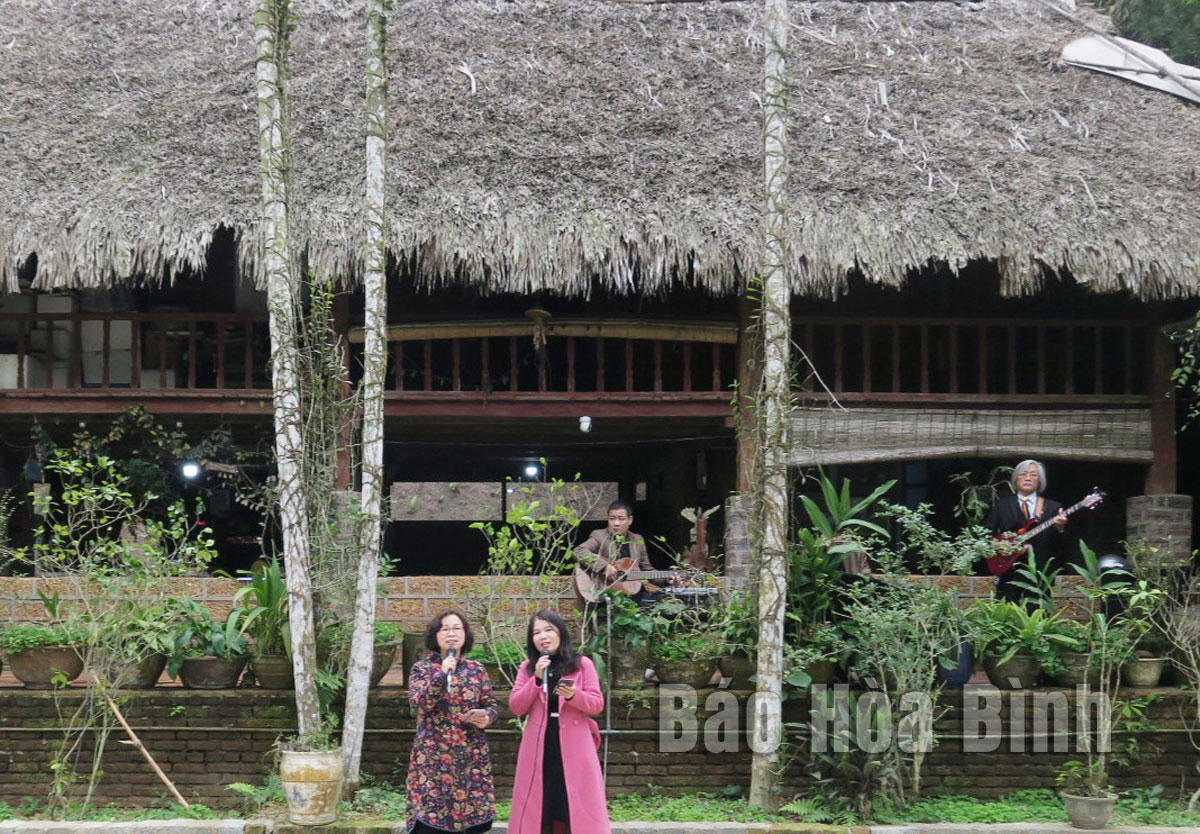
(HBO) – As usual, in the middle of the first Lunar month, on the occasion of the Vietnam Poetry Day, 20 poets from the Literature and Arts Association of Hoa Binh gathered to enjoy poems and music together.

Two poets from the
Literature and Arts Association of Hoa Binh perform the song "Mua xuan dau
tien” (First Spring) at the event.
In a wide space at the private home of painter
and musician Van Thao, the son of famous late music composer Van Cao, the poets
and artists staged many special performances.
Poet Dinh Dang Luong chose the poem entitled
"Nguyen tieu” (first full moon) by President Ho Chi Minh to perform.
Meanwhile, artist and musician Van Thao
introduced his song "Nguoi di tim la dieu bong” (The man searching for dieu
bong leaves) that he wrote about late poet Hoang Cam.
At the event, 15 poems and songs were introduced
and performed by the artists themselves. In the warm atmosphere of Spring,
artist Pham Quang Du played his guitar and sang the "Xuan tren dao” (Spring on
the island) which was about soldiers safeguarding the country’s sky and sea in
Truong Sa.
Poets Le Thanh Hong and Le Mai Thao performed
the "Mua xuan dau tien” (First Spring), a famous song that was composed in 1976
Spring, the first spring after the country was reunified.
With strong emotion, poet Le Mai Thao said that
although this year’s event is small in scale due to impact of COVID-19, it
provided a great chance for the artists to meet and exchange. Thao expressed
his hope that in 2022, the pandemic will be pushed back, so that the Vietnam
Poetry Day will be held in a larger scale with the participation of more
poets.
With an increasingly vibrant and widespread emulation movement aimed at building cultured residential areas and cultured families, Yen Thuy District has been making steady progress toward improving both the material and spiritual well-being of its people, while fostering a civilized, prosperous, beautiful, and progressive community.
Once lacking recreational spaces and community facilities, Residential Group 2 in Quynh Lam Ward (Hoa Binh City) has recently received attention for the construction of a new, spacious, and fully equipped cultural house. The project followed the model of state support combined with public contributions in both labor and funding.
The "All people unite to build cultural life" movement, which has been effectively integrated with Kim Boi district’s socio-economic development goals, is fostering a lively spirit of emulation across local residential areas, hamlets, villages, public agencies, and enterprises. In addition, through the initiative, traditional cultural values are being preserved and promoted, while community solidarity and mutual support in poverty reduction and economic development are being strengthened.
A working delegation of the Hoa Binh provincial People’s Committee led by its Permanent Vice Chairman Nguyen Van Toan on June 11 inspected the progress of a project to build the Mo Muong Cultural Heritage Conservation Space linked to tourism services in Hop Phong commune, Cao Phong district.
Born and growing in the heroic land of Muong Dong, Dinh Thi Kieu Dung, a resident in Bo town of Kim Boi district, in her childhood was nurtured by the sweet lullabies of her grandmother and mother. These melodies deeply imprinted on her soul, becoming an inseparable part of her love for her ethnic group's culture. For over 20 years, this love for her hometown has driven Dung to research, collect, and pass down the cultural values of the Muong people to future generations.
In the final days of May, the Ethnic Art Troupe of Hoa Binh Province organized performances to serve the people in remote, mountainous, and particularly disadvantaged areas within the province. These were not just ordinary artistic shows, but they were the meaningful journeys aimed at spreading cultural values, enhancing the spiritual life of the people and contributing to the preservation of ethnic minority cultural identities.



